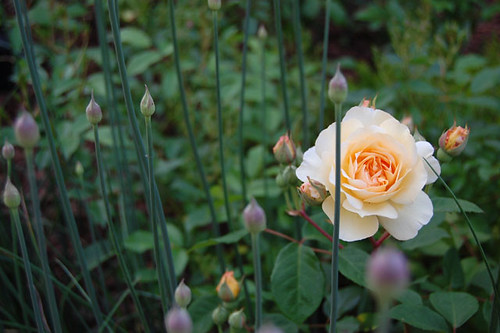Apricot rose and budding alliums by katewrightson
1. Be sure your vegetable garden is in a sunny location away from an area where there might be underlying roots of trees. And it is good to have a watering source nearby.
2. Be sure you have had your soil tested in the last 3 years and you have amended your soil with your extensions recommendations for the plants you want to grow. If you had it amended a few years ago, you can easily get a pH strip to see if the pH is still optimum.
3. Till in the ground cover that was on the soil where you want your plants to grow and work in good compost into the soil.
4. If it’s been more than a couple of weeks since you’ve turned the soil and prepared your beds, then they’ve probably crusted over from rain. Drag a rake over the area a couple of times to break up the crust (you’ll likely need to weed, too). (see here)
5. Make a diagram of your garden with the names of the plants you will grow. It doesn’t have to be fancy. But it will make you decide what you want and how much you need to buy and decide which plants are happy growing together. (see here)
6. If it is a vegetable bed that you have used before, do crop rotation. By rotating where you plant certain vegetables you will be less likely to have problems with pests and soil born diseases if you don’t plant the same plants in the same spots each year.
7. Try companion growing of certain vegetables or flowers that help one another. Some companion plants deter pests or bring out the best flavoring of a crop. I plant alliums (I use flowering onions or garlic) near my roses and irises. (see here)
8. Plant on an overcast day, hopefully it will rain the day after you plant. Do not plant if the soil is muddy- if your shoes get muddy, it is too wet to plant.
9 Apply a sprinkling of grass clippings, straw or other organic leaf material over the seed or around the plant once planted. Do not use treated or store-bought mulches at this stage. The idea is only to protect the seed from wind and water in its infancy.
10 Use newspaper covered with straw between garden rows to eliminate weeds and retain moisture. This dynamic duo works more efficiently together than either one alone. At the end of the growing season, rototill the paper and straw into the soil to decay.

